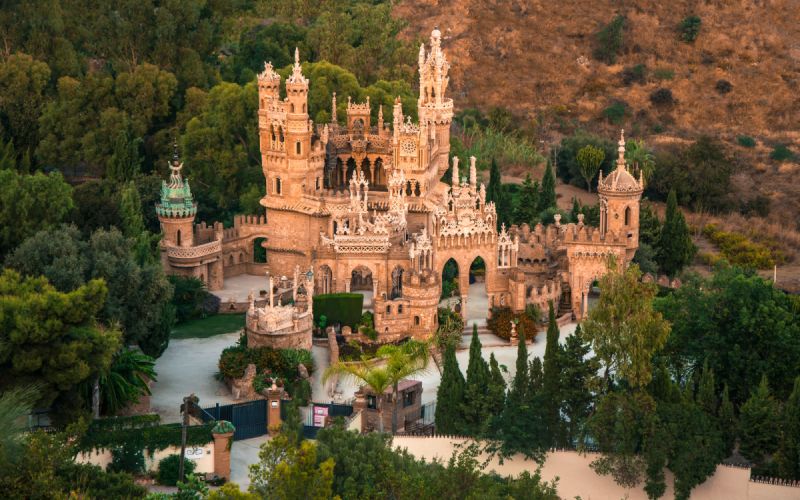The Castillo de Colomares, located near Benalmádena in Spain, is a monument dedicated to the life and adventures of Christopher Columbus. Constructed between 1987 and 1994, it spans an area of 1,500 square meters, making it the largest monument in the world dedicated to Columbus. Remarkably, it also houses the smallest church in the world, which covers just 1.96 square meters.

Construction and Design
The idea for the monument came to life in 1987 when Dr. D. Esteban Martín Martín, with the assistance of two masons, began its construction. Over seven years, using brick, stone, and cement, Dr. Martín crafted this unique structure, which narrates the story of the Discovery of America through its intricate design. Dr. Martín’s extensive knowledge of art, history, and architecture allowed him to create a work that stands out as a “unicum,” a singular piece of art in stone.

Historical Context
Christopher Columbus, an accomplished navigator with knowledge in geography, astronomy, Holy Scripture, mathematics, and humanities, initially presented his exploration plan to several states. Only the Catholic Monarchs of Spain accepted his proposal. Columbus required skilled mariners for his voyages, and he found them in Palos de la Frontera in the Huelva province. Martín Alonso Pinzón, a prominent sailor from this region, helped Columbus gather a crew of experienced seafarers.
The monument features a bronze horse head symbolizing the great sailor from Huelva, depicted as a mythical Pegasus. It also includes bronze shields honoring the crown of Castile and Queen Isabel, who supported and believed in Columbus.

The Voyage
Columbus and his crew set sail from Palos on August 3, 1492, with 96 crew members, most of whom were from Andalusia. After a brief stop in the Canary Islands for provisions and repairs, they continued their journey, reaching an island 33 days later on October 12, 1492. This island was named San Salvador, known to the natives as the “Island of the Iguanas.” Within the castle, there is a small oratory featuring an image of Our Lord Salvador and a sailor bell, commemorating this island.
The three ships used by Columbus—Niña, Pinta, and Santa María—are represented in the Castillo de Colomares. The Niña is depicted at the top of the building beneath the arch of La Rabida, the monastery that sheltered Columbus upon his return from Portugal. The Pinta is featured on the main facade, supported by the Pegasus horse symbol, honoring the Pinzón brothers’ ship. The Santa María stands isolated from the other two, symbolizing its sinking on Christmas Day in Santo Domingo. The 39 crew members of the Santa María who remained on the island perished at the hands of the indigenous people.

Legacy and Reflection
Columbus made four voyages in total, and the Castillo de Colomares includes a mausoleum with a Gothic rose window, symbolizing his fifth and final voyage to eternity. The exact location of Columbus’s remains remains unknown, as does the certainty of his birthplace.

Spain, and Andalusia in particular, played a crucial role in the discovery that fundamentally altered the course of history. Opinions on this monumental event vary, with some viewing it as a positive change and others as a negative one. The Castillo de Colomares stands as a testament to this pivotal moment in history, reflecting both the triumphs and the controversies associated with the Age of Exploration.

